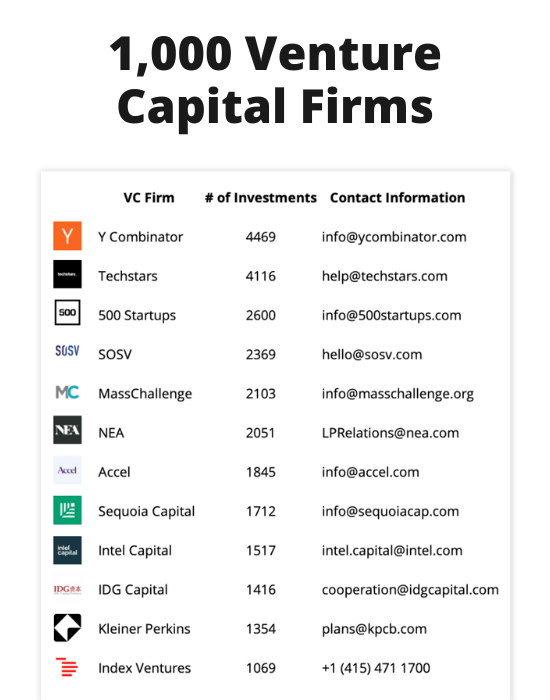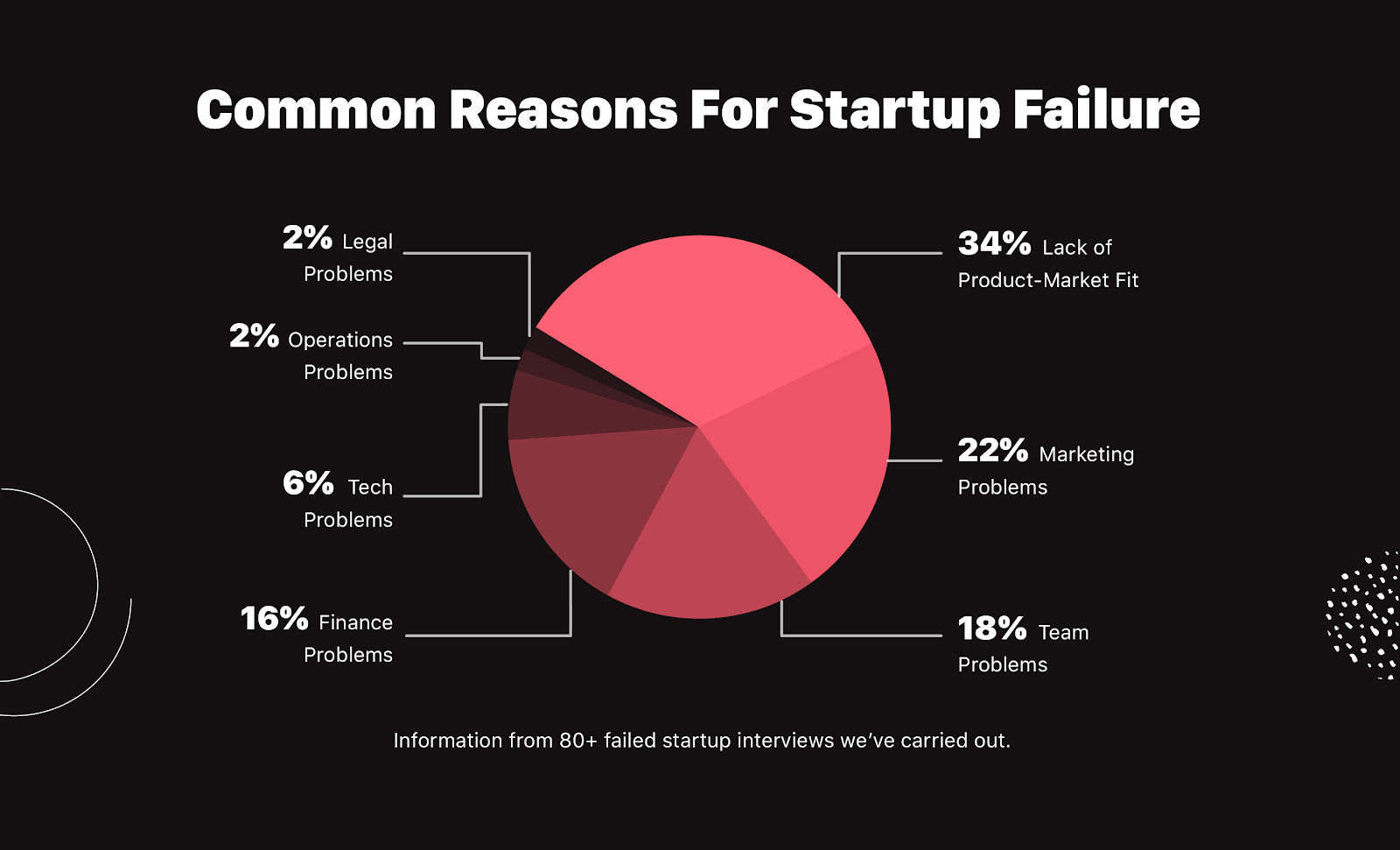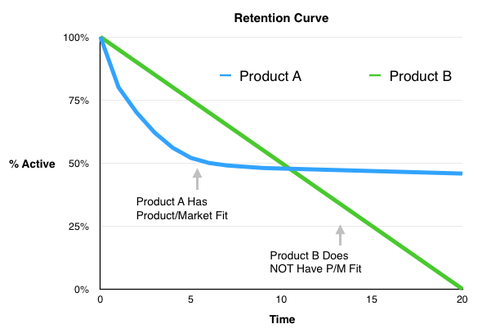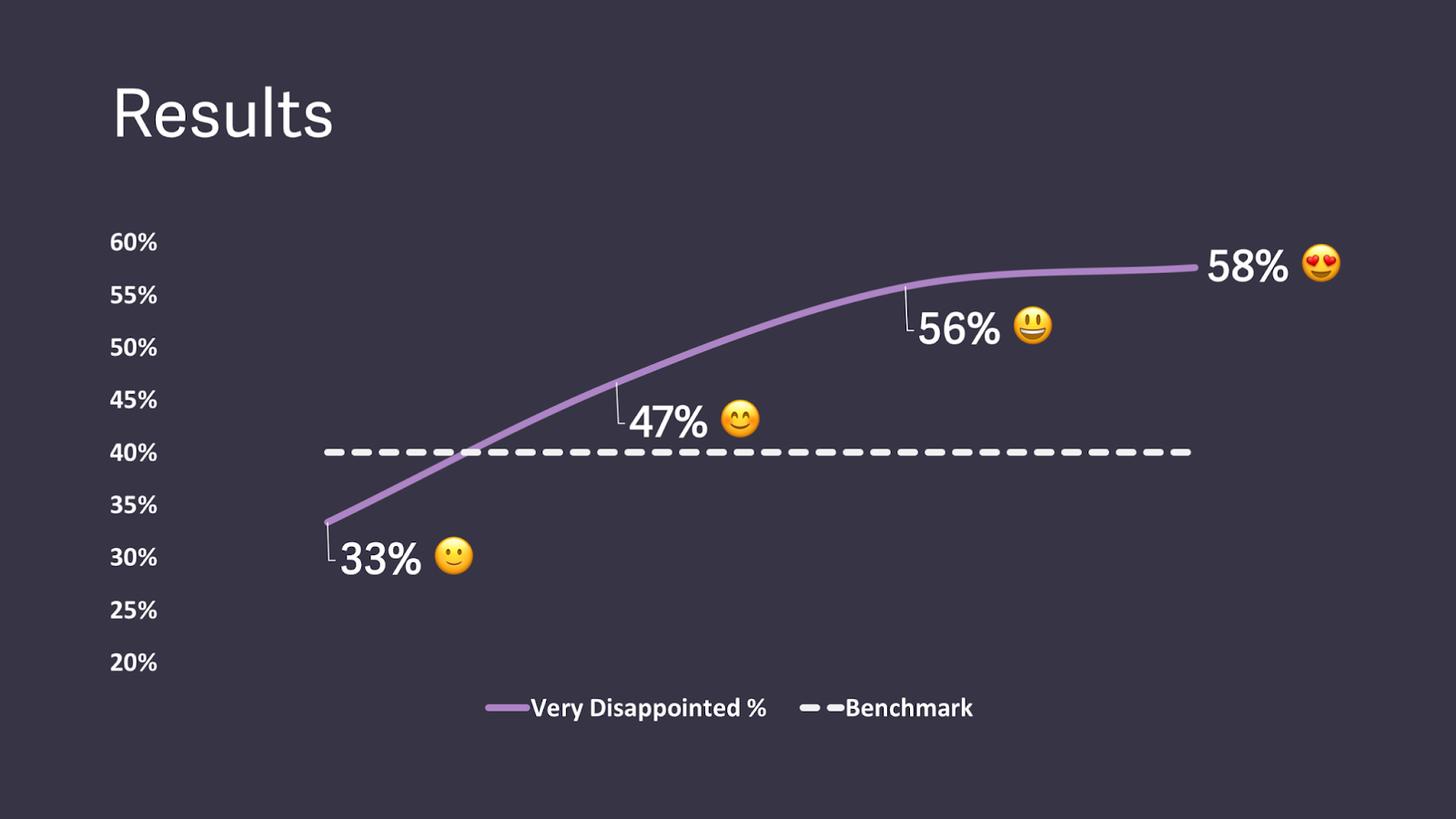
Sheet
1,000 VC Firms
Information about the countries, cities, stages, and industries they invest in, as well as their contact details.
Get the Sheet for $50
In 2007, Marc Andreessen published an article titled “The only thing that matters,” in which he shares one of the most known quotes in the startup scene: “The only thing that matters is getting to product/market fit.”
In this article, we’ll go over what product-market fit is, how to measure it, and how to achieve it. You’ll end the article understanding why Paul claims it to be so important.
What is Product-Market Fit?
Product-market fit is when a company’s target audience of users/customers actively buys, uses, and praises the company’s product/service.
In other words, PMF is when you find the right market for your product/service and your target users/customers are satisfied with what you are selling them.
You can think of PMF as a Venn diagram with one of the circles representing your product and another representing the target market. The section where the two circles overlap in the middle is PMF. This intersection shows a strong link between what you’re offering and the wants and needs of the target market you are selling to.
Why is PMF Important?
After interviewing 80+ failed startups, we discovered that lack of product-market fit is the most common reason for startup failure. 34% of the failed startups we interviewed cited this as their reason for shutting down.

Until you achieve product-market fit, you can’t focus on other important business objectives, such as growing and scaling your business and upselling current users and customers. The quote below sums this up nicely:
“It’s pointless to try to grow without a great offering that you’ve already proven that people want, need, and love.” – Gigi Levy-Weiss, Partner at NFX.
Without PMF, any growth is unsustainable. You can use money, creativity, and persistent effort to get many people to try your product, but if you’re not solving a real-life problem that they are facing, then usage will eventually drop off.
Who’s Responsible for PMF?
Achieving product-market fit generally falls under the marketing and product development teams, but that doesn’t mean they are the only ones responsible for working towards PMF.
In reality, everyone at your company can (and should) play a role in working towards achieving PMF. Consider it a shared responsibility of everyone at your startup, from your sales and marketing teams to your customer support and finance departments.
How To Measure Product-Market Fit
You cannot easily measure product-market fit using a single set of metrics. Instead, most startups that achieve PMF describe it as something you can feel — you know it when you’ve got it. Key signs that you have achieved PMF include:
- Excitement from users (even from just a small group).
- People are willing to pay for your product (even if it’s unfinished).
- Good user retention.
- Customers say they would be disappointed if your product went away.
- Organic growth (driven by word of mouth).
- Can acquire customers for less than they are worth to you (cost-efficient growth).
- People are willing to use your unfinished/unpolished product.
There are several ways to spot the above signs to know if you have achieved PMF.
For starters, you may spot excitement in customers using your product for the first time if you can watch people using it in real life. Or, a small group of users may be actively talking about your product and expressing excitement online.
You can measure your user retention rates by monitoring the percentage of active users over some time. It’s normal to experience a drop-off in users during the first months, but if the percentage of active users flattens off at some point, it’s a good sign of PMF.

PMF Surveys are a great way to find out how customers feel about your product and get answers to questions like: “Would you be willing to pay for this product in its current unfinished state?” or “Would you be disappointed if this product went away?”
Finally, if your user base is growing mainly by word of mouth and without you investing a ton of money in marketing, resulting in cost-efficient customer acquisition, this can be another indicator of PMF.
In a nutshell, you should be able to feel a pull for your product from the target market and not feel like you have to push your idea on anyone.
You may also want to read our extensive guide on How to Measure Product Market Fit.
Is PMF a Yes-No Thing or a Never-Ending Objective?
Product-market fit is both a yes-no thing and a never-ending objective.
Looking at PMF as a yes or no answer to the question of “do you have PMF?” is considered a low-resolution look at PMF. You might be able to say with confidence that you have PMF right now, but the reality is that this can change.
A high-resolution look at product-market fit views it as a continuum — your level of PMF constantly changes as you work on your product/service and as user/customer demands and needs change. In this sense, PMF is a never-ending objective, and you should constantly be working to maintain it.
Here’s an example of how failing to view PMF as a continuum can result in a company shutting down: Blockbuster (and other video stores) had product-market fit for years when physical video rental services had a huge market.
However, as Netflix rose to prominence and streaming services gradually replaced physical video rental, Blockbuster failed to update its business model to maintain PMF, resulting in their permanent closure.
You should always start working on achieving PMF before you even begin building a product or service.
Here are three steps towards achieving product-market fit, from the idea phase through to the minimum viable product (MVP) phase:
1. Validate The Problem’s Existence
Before you start working on your startup idea, you should ensure that the problem your idea will solve exists. This is an important part of evaluating a startup idea and working towards achieving PMF.
There are two main approaches you can take to validate the existence of a problem:
- Post questions or polls to social media, Reddit, blogs, and other online communities to start conversations about the problem you want to solve. This can give you an idea of how people are currently solving the problem and let you decide if it is a big enough problem that would be worth creating a startup around.
- Interview potential customers. You can identify these people on social networks or communities, then reach out to them personally, ideally via a call, with questions regarding the problem.
2. Validate Your Solution
After you’ve validated the existence of the problem you want to solve with your product or service, the next step is to validate your solution.
Validating your solution without building it can be done similarly to proving the existence of a problem. For instance, you can use the same types of online communities that we mentioned above to receive feedback on your idea.
It’s a good idea to build a landing page and mockups of your product idea that explain and show how it will work. You can then share these with your audience to see how they react to the idea and gauge how valid it is.
It’s also a good idea to A/B test different versions of your product or different solutions to the problem you want to solve. You can do this by making multiple landing pages and different mockups and sharing them with even segments of your target audience.
A great way to validate your solution is to run a presale to see how many people are willing to pay for it. We wrote an article about this here.
If a presale doesn’t work for your type of business, a good alternative is to ask people to sign up for a mailing list. If people are giving you their email addresses, they’re interested in what you’re building. You can then also leverage this newsletter to gather feedback on your solution through surveys.
3. Test Your Standing in PMF With an MVP
If you’re able to validate the problem and your solution to the problem successfully, you can go ahead and start building an MVP.
After you launch an MVP, it’s important to closely monitor its performance and usage to determine whether you’re on the path to PMF. As we mentioned, you can track active users, survey customers, and monitor conversations in online communities.
If your new product gains momentum on its own and you notice a demand for it that is growing naturally (without too heavy of an investment in marketing on your end), you likely are on track to achieve PMF.
Here are a few signs of PMF to watch out for when you launch the first versions of your product:
- Frequent demands for new features.
- Customers get annoyed if your product is down or has a bug.
- Early adopters start promoting your product on their own (word-of-mouth growth).
On our Product-Market Fit eBook, you can find the exact strategies used by Airbnb, Slack, Intercom, PayPal, Superhuman, Segment, and ClassPass, to achieve PMF.
2 Common Misconceptions About PMF
Now that you have a better understanding of what product-market fit is, let’s take a look at what it is not.
1) “Companies Can’t Fail After They Achieve PMF”
Just because you have achieved PMF doesn’t mean you can’t lose it. Remember the Blockbuster example above?
This is why it’s so important to view product-market fit as a continuum that you constantly have to work on maintaining. What gives you PMF now can change in a few years, so you need to keep developing your products and services to keep PMF and avoid failure.
2) “PMF Protects You Against Competition”
Many people think that PMF means they have an advantage over their competition, but this isn’t the case. Even if you have a great product and a market that wants it, the competition can still potentially crush you.
So, once you have PMF, you shouldn’t sit back and relax. In fact, you should be doing the opposite and doubling down on efforts in other important areas of your business to increase sales and revenue.
The All-In-One Newsletter for Startup Founders
Every week, I’ll send you the top 10 startup news and resources and an analysis of a failed and a hot company. Join +30,000 other startup founders!
To further understand PMF, it’s helpful to look at how successful startups have achieved it and how they realized when they had done so. Here are 3 examples of companies with different experiences attaining product-market fit:
Superhuman
Superhuman is an email client focused on providing the fastest email experience possible.
To measure their PMF, Superhuman focused on whether or not their users would be disappointed if they could not use their tool any longer.
To measure this, they focused on 100-200 users who had used Superhuman within the past two weeks. They surveyed these users and asked how many would be “very disappointed” if they could no longer use the product. At first, only 22% said they would.
To improve this and meet a goal of at least 40%, Superhuman also included other questions about how they could improve the service.
The answers to these questions allowed them to understand their target market more and make a better product for them. Superhuman was eventually able to get 58% of their users to say that they would be very disappointed if they could no longer use the tool. For Superhuman, this metric was enough to know that they had achieved PMF.

You can read more about how Superhuman found product-market fit here.
Airbnb
Airbnb’s founders started looking for PMF by creating a landing page to determine how many people would be willing to pay to stay at a stranger’s home as an alternative to a hotel when hotels were full during events like conventions.
They determined there was enough interest in the concept, so they went ahead and built an MVP that they tested at the 2008 Democratic Convention in Denver. This first test failed to show that the company had PMF, but this didn’t deter Airbnb’s founders.
Airbnb’s founders continued to refine their project and shift from offering an alternative to hotels to offering something better than hotels. They were able to achieve PMF after about two years. Joe Gebbia, co-founder of Airbnb, stated that he knew the company had PMF after his mother booked her first Airbnb stay.
Here’s a case study on how Airbnb found PMF.
Segment
B2B customer data platform Segment spent 12 months building an analytics tool that never got any customers. After realizing they didn’t have PMF and seeing that they only had about $100K left in the bank, Segments founders decided to switch gears and make a completely different product.
The company already had an open-source library that collected user data from their previous project and was able to send it to different analytics tools. They saw some interest in this and decided that they could build a B2B business on top of it.
They had noticed that a small segment of their previous target audience, mainly founders, executives, and managers, was interested in this data tool, so they focused on building a product for this specific segment of the market.
After discarding their initial idea and focusing all their efforts on building the B2B customer data platform, Segment realized they had PMF when they had a solid user base of customers who returned to derive value from their product week after week, which is the metric they chose to focus on for measuring product-market fit.
You can read more about how Segment achieved product-market fit here.
These 3 case studies are also covered in depth on our Product-Market Fit eBook.
Wrapping Up: 10 Things To Remember About PMF
These are the main 10 things you should keep from this article.
1) You have product-market fit when you are solving a real problem, and the market strongly wants your product.
2) Lack of PMF is the number one reason for failed early-stage startups (our data shows that 34% of closed startups cite this as the reason).
3) Finding PMF means finding a valid solution to a substantial problem. In the early stages of your startup, this means finding and exploring a minimum viable segment (MVS), or a group of people with the same problem that you can solve, and creating a minimum viable product (MVP) for them to test to see if there is a good PMF.
4) Before you build an MVP, you must validate the problem’s existence and the viability of your theoretical solution (AKA, your product promise). Doing this helps ensure your MVP is relatively close to having PMF at launch. The best ways to check for PMF before building an MVP are:
- Customer interviews.
- Landing pages and product mockups.
- Exploratory content on social media and other online communities.
- A mailing list of potential customers.
- Presales.
5) Once you have an MVP, you need to test your actual product against the market and iterate based on customer feedback. To measure success, you need to use the right metrics; precisely a metric that shows usage and a metric that shows retention. Good ways to measure your PMF at this stage are:
- Engagement data from Google Analytics + internal data.
- Customer surveys (“How disappointed would you be if you could no longer use this product?”).
- Customer interviews.
6) Don’t get fooled by vanity metrics like social media follows, registered users, website visitors, capital raised, and other similar metrics — these are not good indicators of PMF. Instead, you should feel a strong demand and pull from customers for your product.
7) Segmenting your users is the best way to understand your target market, identify new opportunities, and help you interpret feedback and data correctly.
8) Discard ideas that aren’t working, no matter how much effort and money you’ve put into them (like in the Segment example mentioned above). Test as many iterations and ideas as possible to increase your chances of finding PMF.
9) If you doubt whether you have PMF, you probably don’t. Remember that most successful startups know when they have PMF. Keep iterating or trying new ideas until you feel an obvious pull from the market.
10) Product-market fit isn’t everything you need to succeed, but it’s the most important thing in the early stages of a startup. Focus most of your efforts on PMF until you have solid proof you’ve found it. Once you do, you can focus on growth and scaling up.




